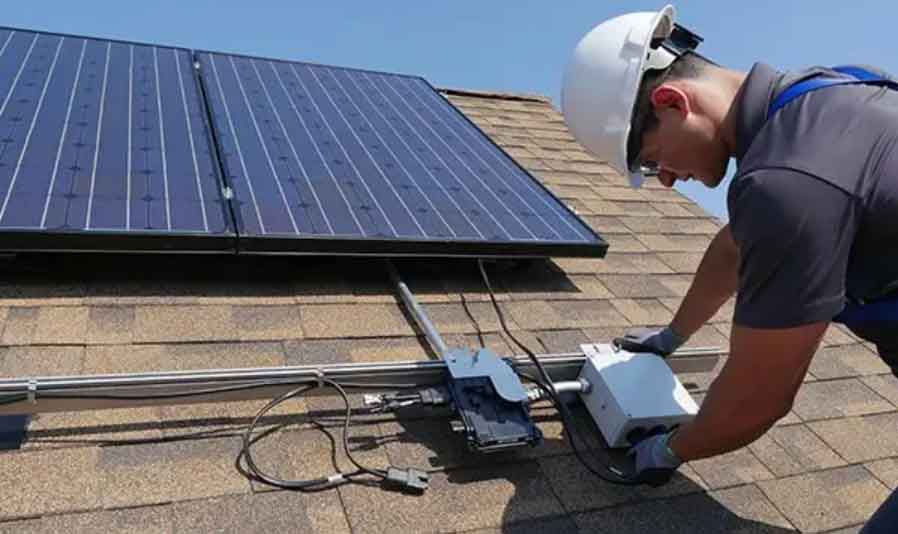Introduction
The adoption of solar energy has seen significant advancements in recent years, with technological innovations enhancing the efficiency and reliability of photovoltaic panels. One such innovation is the micro inverter, a critical component that optimizes solar energy harvest by converting direct current (DC) generated by individual solar panels into alternating current (AC) suitable for use in homes and businesses. This article explores the benefits of micro inverters, their role in optimizing solar energy harvest, and how they compare to traditional string inverters.
Understanding Micro Inverters
Micro inverters are small inverters attached to each photovoltaic panel in a solar energy system. Unlike traditional string inverters, which convert the combined DC output of multiple panels into AC, micro inverters work independently on each panel. This approach offers several advantages in terms of efficiency, performance, and reliability.

Table 1: Comparison of Micro Inverters and String Inverters
| Feature | Micro Inverters | String Inverters |
|---|---|---|
| Efficiency | High, as each panel operates independently | Lower, as performance is limited by weakest panel |
| Installation | More complex, requires individual connections | Simpler, fewer connections required |
| Monitoring | Panel-level monitoring and diagnostics | System-level monitoring only |
| Flexibility | Ideal for complex roofs with shading issues | Best for uniform, unobstructed installations |
| Cost | Higher initial cost | Lower initial cost |
| Reliability | Increased system reliability | Dependent on single inverter for multiple panels |
Benefits of Micro Inverters
The use of micro inverters in solar energy systems provides several key benefits that enhance overall system performance and efficiency. These benefits make micro inverters an attractive option for both residential and commercial solar installations.
List: Key Benefits of Micro Inverters
- Increased Energy Harvest: Each photovoltaic panel operates at its maximum potential, increasing overall energy production.
- Improved System Reliability: Independent operation of panels means that a failure in one does not affect the others.
- Enhanced Monitoring and Diagnostics: Panel-level monitoring allows for precise performance tracking and early detection of issues.
- Flexibility in Design: Suitable for complex roof designs and installations with partial shading.
- Simplified Maintenance: Easier to identify and address specific panel issues without impacting the entire system.
Increased Energy Harvest
Micro inverters optimize the energy harvest from each photovoltaic panel by ensuring that shading, dirt, or other issues affecting one panel do not impact the performance of the others. This results in higher overall energy production, particularly in installations with variable shading or orientation.
Table 2: Energy Production Comparison (Hypothetical Scenario)
| Condition | Micro Inverters (kWh/year) | String Inverters (kWh/year) |
|---|---|---|
| Ideal Conditions | 10,000 | 9,800 |
| Partial Shading | 9,500 | 8,500 |
| Mixed Panel Orientations | 9,200 | 8,200 |
Improved System Reliability
With micro inverters, the failure of a single panel or inverter does not bring down the entire system. This distributed approach enhances the overall reliability and resilience of the solar energy system, ensuring consistent power generation even if individual components fail.
List: Reliability Advantages of Micro Inverters
- Distributed Risk: Minimizes the impact of individual panel or inverter failures.
- Redundancy: Provides backup performance if one inverter fails, the rest continue to operate.
- Longer System Lifespan: Reduces strain on individual components, potentially extending the lifespan of the system.
Enhanced Monitoring and Diagnostics
Micro inverters enable panel-level monitoring, providing detailed insights into the performance of each photovoltaic panel. This granular data helps in identifying underperforming panels and diagnosing issues early, facilitating timely maintenance and optimizing overall system performance.
Table 3: Monitoring Capabilities Comparison
| Monitoring Feature | Micro Inverters | String Inverters |
|---|---|---|
| Performance Tracking | Panel-level | System-level |
| Issue Detection | Precise, panel-specific | General, system-wide |
| Maintenance Efficiency | Targeted, quick identification | Broader, less precise |
Flexibility in Design
Micro inverters offer greater flexibility in system design, making them ideal for installations on complex roofs with multiple orientations and partial shading. This adaptability allows for more efficient use of available space and maximizes solar energy harvest.
List: Design Flexibility Benefits
- Multiple Orientations: Supports installations on roofs with different angles and orientations.
- Shading Mitigation: Minimizes the impact of shading on overall system performance.
- Custom Configurations: Allows for creative and efficient use of available roof space.
Simplified Maintenance
The ability to monitor and diagnose issues at the panel level simplifies maintenance. Technicians can quickly identify and address specific problems without needing to troubleshoot the entire system, reducing downtime and maintenance costs.
Table 4: Maintenance Comparison
| Maintenance Aspect | Micro Inverters | String Inverters |
|---|---|---|
| Issue Identification | Quick, panel-specific | Slower, system-wide |
| Repair Efficiency | Targeted, minimal disruption | Broader, more disruptive |
| Downtime | Minimal, as unaffected panels continue | Higher, as entire string may be impacted |
Case Studies of Micro Inverter Integration
Several real-world examples demonstrate the effectiveness of micro inverters in optimizing solar energy harvest and enhancing system performance.
Case Study 1: Residential Installation
Location: San Francisco, California
System Size: 6 kW
Configuration: 20 photovoltaic panels with micro inverters
Outcome: Increased energy production by 15% compared to a similar system with string inverters, improved performance during partial shading, and enhanced monitoring capabilities.
Case Study 2: Commercial Installation
Location: Sydney, Australia
System Size: 100 kW
Configuration: 300 photovoltaic panels with micro inverters
Outcome: Significant energy savings, improved reliability, and detailed performance data enabling proactive maintenance and optimization.
Conclusion
Micro inverters play a crucial role in optimizing solar energy harvest by enhancing the efficiency, reliability, and flexibility of photovoltaic panel systems. Their ability to operate independently on each panel, provide detailed monitoring, and adapt to complex installation environments makes them an excellent choice for both residential and commercial solar projects. As the demand for renewable energy continues to grow, the benefits of micro inverters will become increasingly important in maximizing the potential of solar energy systems and achieving energy sustainability.
